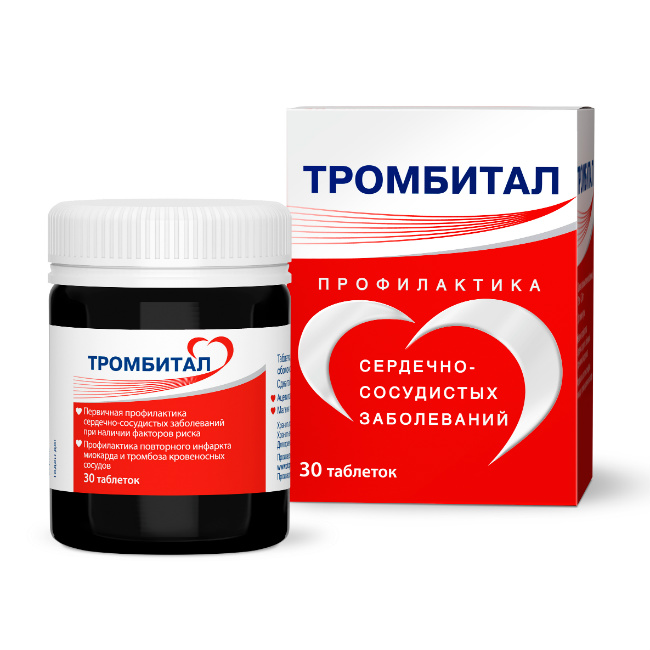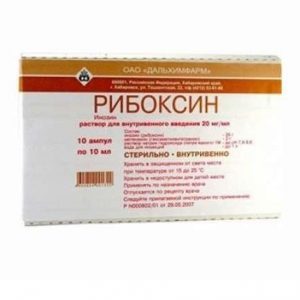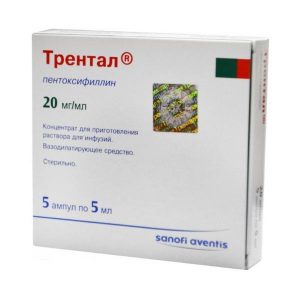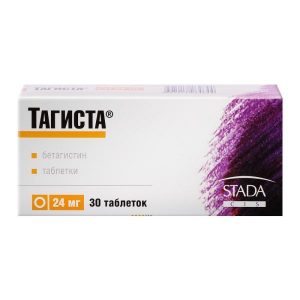Description
Latin name
TROMBITAL
Release form
Film-coated tablets, white or almost white, round, biconvex on a cross section, the core is white or almost white.
packaging 30 pcs
Pharmacological action
Reduces aggregation, platelet adhesion and thrombosis by inhibiting the synthesis of thromboxane A2 in platelets. The antiplatelet effect persists for 7 days after a single dose (more pronounced in men than in women).
Acetylsalicylic acid reduces mortality and the risk of developing myocardial infarction with unstable angina, is effective in the primary prevention of diseases of the cardiovascular system, especially myocardial infarction in men over 40, and in the secondary prevention of myocardial infarction.
Suppresses the synthesis of prothrombin in the liver and increases prothrombin time. It increases the fibrinolytic activity of blood plasma and reduces the concentration of vitamin K-dependent coagulation factors (II, VII, IX, X). Increases the risk of hemorrhagic complications during surgical interventions, increases the risk of bleeding during anticoagulant therapy.
Acetylsalicylic acid in high doses also has an anti-inflammatory, analgesic, antipyretic effect.
In high doses, acetylsalicylic acid stimulates the excretion of uric acid (disrupts its reabsorption in the renal tubules).
Blockade of COX-1 in the gastric mucosa leads to inhibition of gastroprotective prostaglandins, which can lead to ulceration of the mucous membrane and subsequent bleeding.
Magnesium hydroxide, which is part of the drug Thrombital, protects the gastrointestinal mucosa from exposure to acetylsalicylic acid.
Indications
– primary prevention of cardiovascular diseases such as thrombosis and acute heart failure in the presence of risk factors (e.g. diabetes mellitus, hyperlipidemia, hypertension, obesity, smoking, old age)
– prevention of myocardial infarction and myocardial infarction vascular
– prevention of thromboembolism after vascular surgery (coronary artery bypass grafting, percutaneous transluminal coronary angioplasty)
– unstable nocardia.
Contraindications
– hypersensitivity to acetylsalicylic acid, excipients of the drug and other NSAIDs
– cerebral hemorrhage
– bleeding tendency (vitamin K deficiency, thrombocytopenia, hemorrhagic diathesis)
– erosive and ulcerative gastrointestinal tract in the acute phase
– gastrointestinal bleeding, srd salicylates and other NSAIDs
– a complete or incomplete combination of bronchial asthma, recurrent polyposis of the nose and paranasal sinuses with intolerance to acetylsalicylic acid or other NSAIDs, including COX-2 inhibitors (including history)
– concomitant use of methotrexate at a dose of 15 mg per week or more
– I and III trimesters of pregnancy
– breastfeeding period
– glucose-6-phosphate dehydrogenase deficiency
– severe renal failure / Kpr less than 30 ml – severe liver failure (Child and Pugh class B and C)
– chronic heart failure of FC III and IV according to
classification NYHA
– children under 18 years of age.
Caution
For gout, hyperuricemia, as acetylsalicylic acid in small doses reduces the excretion of uric acid.
If there is a history of gastric ulcer or gastrointestinal bleeding.
With liver failure (class A on the Child-Pugh scale).
In renal failure (CC more than 30 ml / min).
For bronchial asthma, chronic respiratory diseases, hay fever, nasal polyposis, allergic conditions, drug allergies.
In the second trimester of pregnancy.
With diabetes.
In elderly patients.
With the proposed surgical intervention (including minor ones, for example, tooth extraction), as acetylsalicylic acid may cause a tendency to develop bleeding within a few days after taking the drug.
When taken concurrently with the following drugs (see section Drug Interactions):
with methotrexate at a dose of less than 15 mg per week
with anticoagulants, thrombolytic or antiplatelet agents
– with NSAIDs and high-dose salicylic acid derivatives
– with digoxin
– with hypoglycemic agents for intramuscular (sulfonylurea derivatives) and insulin
– with valproic alcohol srdl alcohol with selective serotonin reuptake inhibitors
– with ibuprofen
– with lithium preparations
– with systemic corticosteroids
– with ethanol
– with narcotic analgesics
– with sulfanilamides
– with carbonic inhibitors PS.
Use during pregnancy and lactation
Thrombital is contraindicated for use in the I and III trimesters of pregnancy, because has a teratogenic effect – when used in the first trimester of pregnancy, the fetus splits the upper palate, in the third trimester it causes inhibition of labor (suppression of prostaglandin synthesis), premature closure of the ductus arteriosus pulmonary vascular hyperplasia and hypertension in the pulmonary circulation.
Taking the drug in the second trimester is possible only if the potential benefit to the mother outweighs the risk to the fetus.
Salicylic acid crosses the placental barrier.
Acetylsalicylic acid and its metabolites are excreted in breast milk. Breastfeeding should be discontinued during treatment.
Composition
Per tablet:
Active ingredients:
acetylsalicylic acid – 75.00 mg,
magnesium hydroxide – 15.20 mg.
Excipients:
microcrystalline cellulose – 12.07 mg,
corn starch – 9.50 mg,
potato starch – 2.00 mg,
magnesium stearate – 0.15 mg.
Shell:
hypromellose (hydroxypropyl methylcellulose 15 cPs) – 0.60 mg, macrogol (polyglycol 4000) – 0.12 mg, talc – 0.36 mg.
Dosage and administration
The drug is taken orally, 1 time / day, washed down with water. The tablet can be swallowed whole, chewed or pre-ground.
Primary prophylaxis of cardiovascular diseases such as thrombosis and acute heart failure in the presence of risk factors (for example, diabetes mellitus, hyperlipidemia, hypertension, obesity, smoking, old age): Take 2 tablets of Trombital on the first day, then 1 tablet 1 time / day.
Prevention of recurrent myocardial infarction and blood vessel thrombosis: 1-2 tablets of the drug Thrombital 1 time / day.
Prevention of thromboembolism after vascular surgery (coronary artery bypass grafting, percutaneous transluminal coronary angioplasty): 1-2 tablets of the drug Thrombital 1 time / day.
Unstable angina: 1-2 tablets of the drug Thrombital 1 time / day. For faster absorption, the first tablet is recommended to chew.
The drug is intended for prolonged use. The duration of treatment and the dose of thrombital are determined by the doctor.
Use the drug only according to the indications, the method of use and at the doses indicated in the instructions.
Side effects
Definition of categories of frequency of adverse events: very often (with a frequency of more than 1/10), often (with a frequency of at least 1/100, but less than 1/10), infrequently (with a frequency of at least 1/1000, but less than 1/100), rarely (with a frequency of not less than 1/10000, but less than 1/1000), very rarely (with a frequency of less than 1/10000), including individual messages.
From the hemopoietic system: very often – increased bleeding (hematomas, nosebleeds, bleeding gums, bleeding from the genitourinary tract) rarely – anemia very rarely – hypoprothrombinemia, thrombocytopenia, neutropenia, aplastic anemia, eosinophilia, agranulocytosis unknown. There are reports of serious cases of bleeding, which include gastrointestinal bleeding and cerebral hemorrhage (especially in patients with arterial hypertension, not reaching the target blood pressure values and / or receiving concomitant therapy with anticoagulant drugs), which in some cases can be life-threatening in nature. Bleeding can lead to the development of acute or chronic posthemorrhagic / iron deficiency anemia (for example, due to occult bleeding) with the corresponding clinical and laboratory signs and symptoms (asthenia, pallor, hypoperfusion). There are reports of cases of hemolysis and hemolytic anemia in patients with severe glucose-6-phosphate dehydrogenase deficiency.
Allergic reactions: often – urticaria, Quincke’s edema infrequently – anaphylactic reactions, including angioedema, frequency unknown – skin rash, skin itching, rhinitis, swelling of the nasal mucosa, cardio-respiratory distress syndrome, as well as severe reactions, including anaphylactic shock.
From the side of the nervous system: often – headache, insomnia infrequently – dizziness, drowsiness rarely – tinnitus, intracerebral hemorrhage, frequency is unknown – hearing loss, which may be a sign of drug overdose (see section Overdose).
From the respiratory system: often – bronchospasm.
From the digestive system: very often – heartburn often – nausea, vomiting infrequently – pain in the abdomen, ulcers of the mucous membrane of the stomach and duodenum, incl. perforated (rare), gastrointestinal bleeding rarely – increased activity of liver enzymes is very rare – stomatitis, esophagitis, erosive lesions of the upper gastrointestinal tract, strictures, irritable bowel syndrome, colitis, frequency is unknown – decreased appetite, diarrhea.
From the urinary system: frequency unknown – impaired renal function and acute renal failure.
If the side effects noted above are noted, or they are aggravated, or any other side effects appear, the patient should inform the doctor about it.
Drug Interaction
With the simultaneous use of acetylsalicylic acid enhances the effect of the following drugs:
– methotrexate by reducing renal clearance and displacing it from the connection with proteins, the combination of acetylsalicylic acid analgesics, other NSAIDs
– heparin and indirect anticoagulants due to impaired platelet function and displacement of direct anticoagulants due to the connection with the plasma proteins
– thrombolytic, antiplatelet and anticoagulant drugs (ticlopidine)
– digoxin due to a decrease in its renal excretion
– hypoglycemic agents for ingestion (sulfonylurea derivatives) and insulin due to the hypoglycemic properties of acetylsalicylic acid itself of valproic acid by displacing it from its connection with the plasma proteins.
Concurrent use of acetylsalicylic acid with ibuprofen leads to a decrease in the cardioprotective effects of acetylsalicylic acid.
The combination of acetylsalicylic acid with anticoagulants, thrombolytics and antiplatelet agents is accompanied by an increased risk of bleeding.
Concurrent administration with acetylsalicylic acid increases the concentration of barbiturates and lithium salts in blood plasma.
By increasing the elimination of salicylates, systemic ACS attenuates their action.
GCS, ethanol and ethanol-containing drugs increase the adverse effects on the gastrointestinal mucosa and increase the risk of gastrointestinal bleeding.
When acetylsalicylic acid and ethanol are taken concomitantly, the toxic effect of ethanol on the CNS is increased.
Acetylsalicylic acid attenuates the action of uricosuric drugs – benzbromarone, probenecid (decreased uricosuric effect due to competitive suppression of renal tubular excretion by uric acid), ACE inhibitors (there is a dose-dependent decrease in glomerular filtration rate as a result of inhibition of prostaglandins having vasodilator action and, accordingly, attenuation of antihypertensive action), diuretics (when combined with acetylsalicylic acid, the synthesis of high levels ).
Antacids and cholestyramine reduce acetylsalicylic acid absorption.
If a patient uses the above or other medicines (including over the counter), consult a doctor before taking Trombital.
Storage conditions
The drug should be stored out of the reach of children at a temperature not exceeding 25 ° C.
Expiration
2 years.
Deystvuyuschee substances
Atsetylsalytsylovaya acid, [magnesium hydroxide]
pharmacy terms and conditions without a prescription
dosage form
dosage form
tablets




